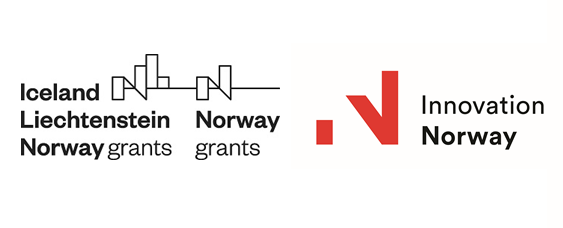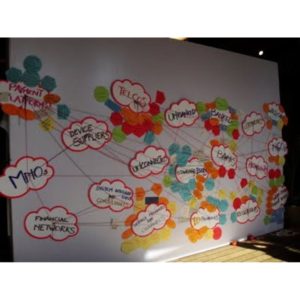Or… what has been brought into the light as a result of the 2 days of brainstorming and team working powered by SWIFT’s Innotribe in Mumbai.
Innotribe Mumbai has been a mixture of very interesting presentations approaching different angles and highly interactive group exercises which allowed people to get to know each other, state the issues they or their partners confront with and ideas for possible resolutions.
The mobile payments world
The first day has produced this spider web of the mobile payments world, connecting 19 (and these aren’t even ALL ) different types of participants through these very thin colored threads. Although discussions between innotribers did not really touch the “banked” and tried focusing mostly on the “unbanked”, the main issue is exactly the same in both cases: connectivity to this multi-colored world. The links aren’t always there, the banked are not very well connected either. Correspondent banking is something many talk about but not everybody has successfully implemented.
Open platforms
Looking at the above map and trying to mold it on the globe, it becomes clear that all these isolated entities need to be able to communicate in a very easy and efficient way with the type of peer they’re linked to. Efficient does not mean using proprietary closed means of communication, but something that is available out there, ready to be evaluated and used by any interested party at any time. Openness. Otherwise, trying to pin in 8000+ banks, hundreds of millions of people, tons of financial networks and so on reads only one word: chaos.
But would it be possible to connect everybody? We’ve embraced the why not and why in tens of years and not now approach. Then how? Open platforms. Open APIs which enable rapid integration between all these members of the financial world.
Let’s take Google as an example. What does Google have that banks don’t?
Google does not charge for payments, it has built a platform free, easy and attractive to use. Mmm, so what’s in it for them? They make full benefit of each and every person’s actions; whether these are tweets, likes, dislikes, locations, purchases, community contributions, all these form a valuable stream of big data which create a very specific profile of an individual. It is a fact that people are becoming more and more spam-proof, they have simply learned to adapt in such a way as to avoid unrequested or irrelevant information. Reaching these persons needs a different approach, and Google has taken that path: by discovering someone’s preferences, you could start thinking of how to target that user; starting point is identifying this person’s set of values and needs. Vanessa Miemis, the creator of last fall’s “The Future of Money” short movie, has come up in Mumbai with episode #2: “The Future of Facebook” – an excellent social brief that brings the individuals forward, placing them into the center of attention. She basically encourages talking about human inclusion instead of financial inclusion. Shifting focus to the people.
In India, understanding life and who these generically called “unbanked” people can be a very long and complex project. I’ll try name only but a few of the things I’ve learned these past 2 days.
As a picture’s worth a thousand words, these are unbanked people:
Please keep in mind these pictures have been taken in Mumbai, one of the largest and most developed cities of India, which also is considered the financial capital of the country.
To further deep dive into the problem, there are entire villages in India which don’t even have electricity. In this context, mobile penetration is at the max, which creates great opportunity for banks and service providers, would they only know the best recipe of getting to all these people.
Could apps be an answer? No. Not for the unbanked, the only lines of communication is basic GSM, SMS functionality included. SMS however has a huge problem: great numbers of these people are unable to read, or if they can, they can’t understand anything other than their native language. Thus thinking far into the direction of hardware or sophisticated software doesn’t lead anywhere. All these above issues are not solely occurring in India, Kenya for instance is facing the exact same troubles, other developing countries too.
At Innotribe, there were some very interesting talks and product pitches regarding voice prints. Using voice instead of text. That has potential and, if cheap technology, is something that could really work in the unbanked case.
e-Wallets
Kenya has a vast offer of e-wallets, are they what was missing? Yes they could have been, if only they would translate into a single e-money currency, but since no interoperability between service providers exists, this is very hard to achieve at the moment.
To try and wrap this long post up, the next step or one of the many following steps for global inclusion would be making things clear and simple and open. Open platforms to enable interoperability.
By: Ioana Guiman














